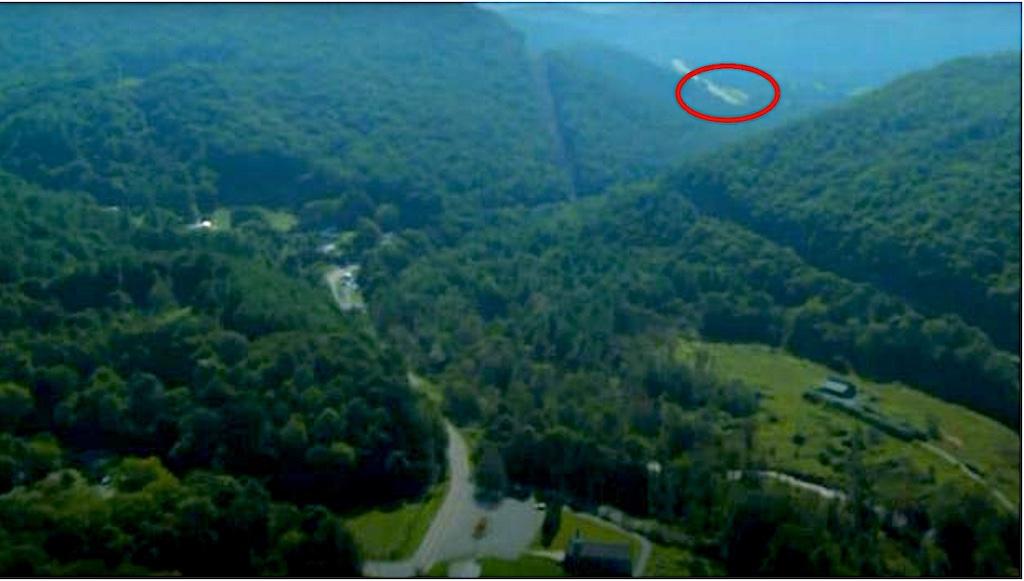
Elk River Airport seen from the dogleg to final approach with the runway circled.
Part 135 operator Nicholas Air maintained a list of 21 restricted airports.
Six of those were listed as day/visual flight rules (VFR)-only, and 10 were daytime-only. Elk River Airport (NC06) was not on the list, despite the clear hazards explained by the airport itself.
Nicholas Air was approved by the FAA to have a second-in-command professional development program. It allowed newly hired commercial pilots to log flight time while flying in the right seat of an aircraft that did not require a second pilot. The Phenom can be flown by either one or two pilots, and Nicholas Air chose to train pilots-in-command to fly as a single pilot. In an interview, the FAA principal operations inspector expressed reservations about having pilots with little or no previous jet time flying with captains who are trained and checked as single pilots.
The operator was also an authorized “eligible on-demand” certificate holder. The status allowed it to reduce the effective runway length requirements of its turbine-engine-powered aircraft using a Destination Airport Analysis Program (DAAP). A DAAP allows an operator to plan to use 80% of a runway for landing instead of the 60% normally required by 14 CFR 135.385.
To be approved as an eligible on-demand operator and thereby reduce its safety margins for landings, the company was supposed to comply with 14 CFR Part 135.23(r), which lists 10 factors to be considered. One of these was pilot qualifications and experience, and another was airport facilities and topography.
The accident captain was supposed to get permission from the director of operations before using the 80% rule to plan the flight, but did not. When investigators asked Aircraft Performance Group, the DAAP vendor, to provide the calculation for the flight, it determined the jet would have been too heavy to land at NC06 if pilots used the 60% rule. Using either flaps 3 or flaps full, the maximum allowable landing weight would have been 13,267 lb., not 17,042.
Conclusions And Comments
The NTSB described the probable cause finding of the accident as “the pilot’s failure to achieve the approach criteria for the available runway landing distances published in the Pilot Operating Handbook, likely as a result of the steeper-than-normal approach and the required left turn on short final to avoid the terrain surrounding the airport.”
The unorthodox maneuvers required in the last moments before landing made compliance with the manufacturer’s assumptions very difficult. It would not have mattered if the runway had been long enough, but it was not. It was the flight crew’s responsibility to recognize this.
There were two contributing factors: lower than expected runway friction, and no consideration of airport terrain in the DAAP.
The Runway Condition Assessment Matrix (RCAM) is a fine tool for estimating braking effectiveness on landing, but it must be taken with a grain of salt.
The RCAM says a wet runway with less than one-eighth in. of water on it is a “5,” and provides good braking. However, if a pilot is approaching an unfamiliar, ungrooved runway when rain is falling, it would be very unwise of he or she to assume the aircraft will experience “good” braking, even if water has not risen to a depth of one-eighth in.
DAAP programs provide very precise numerical values for maximum weights and landing distances, but they incorporate fudge factors that are basically guesswork. A pilot should not be misled into thinking the precise numbers are as accurate as they seem. The approach to NC06, with its mountains, trees and nearby cliffs and rivers, does not lend itself to precise predictions about landing distance. Part 135 operators should take a close look at terrain and obstacles near an airport when planning a flight there.
In its analysis, the NTSB did not consider what effect the co-pilot’s low jet experience might have had on the outcome. A more experienced pilot might have challenged the pilot-in-command’s assertion that they could land in the rain. While that might be true, the absence of a caution or callout does not make a very good probable cause.
Two important stopping technologies were not a factor in the Elk River Airport accident analysis: runway grooving and thrust reversers. Grooving is very effective in improving stopping on watery runways, as long as the runway does not become completely flooded. Reversers allow an aircraft to decelerate regardless of the surface condition.
As a pilot who spent most of his career flying aircraft equipped with thrust reversers, I appreciate their added stopping power. I can recall many times that reversers provided a very reassuring deceleration when I was landing on a contaminated runway.
Reversers may not be practical on light jets like the Phenom, but their absence is another argument for being conservative in making last-minute decisions to either land or go around.
To read “Slippery Runway Causes A Phenom Excursion, Part 1,” click here.
To read “Slippery Runway Causes A Phenom Excursion, Part 2,” click here.





